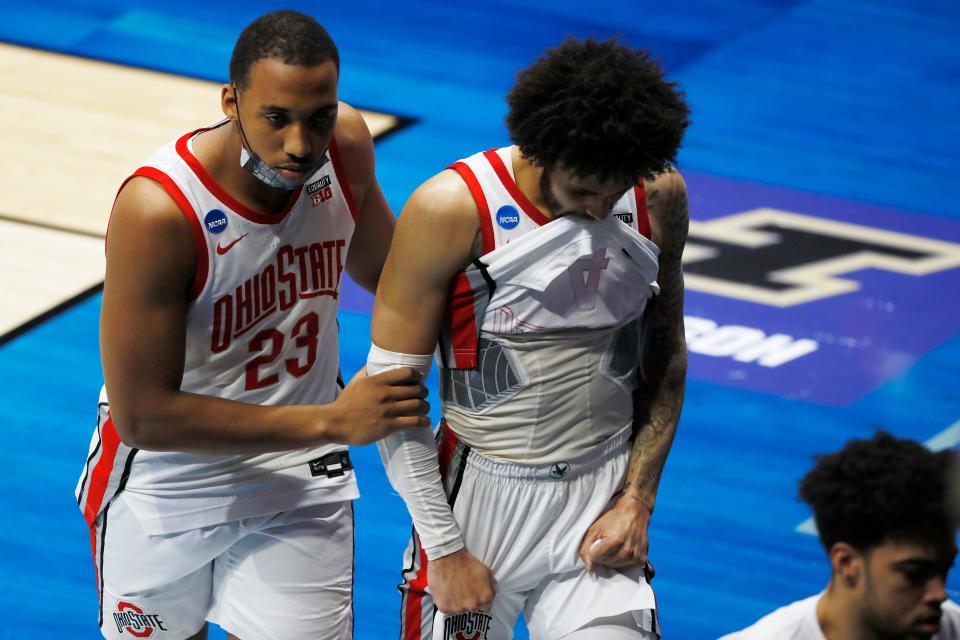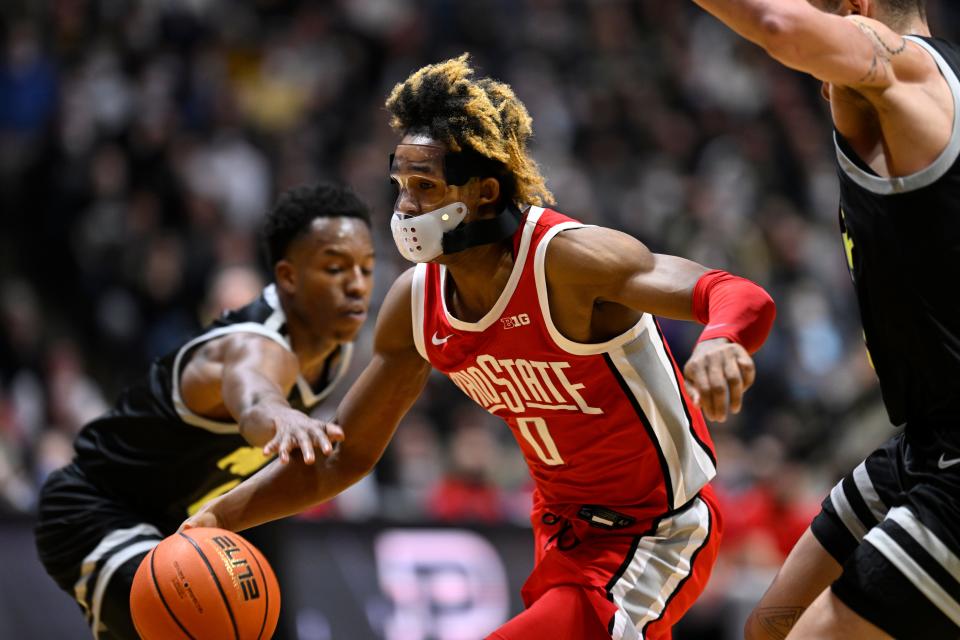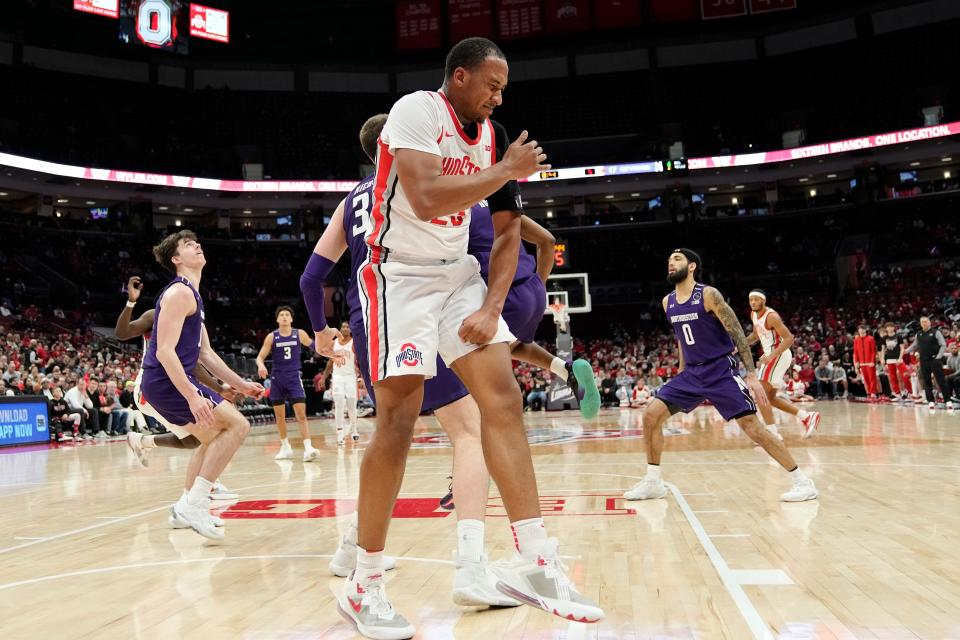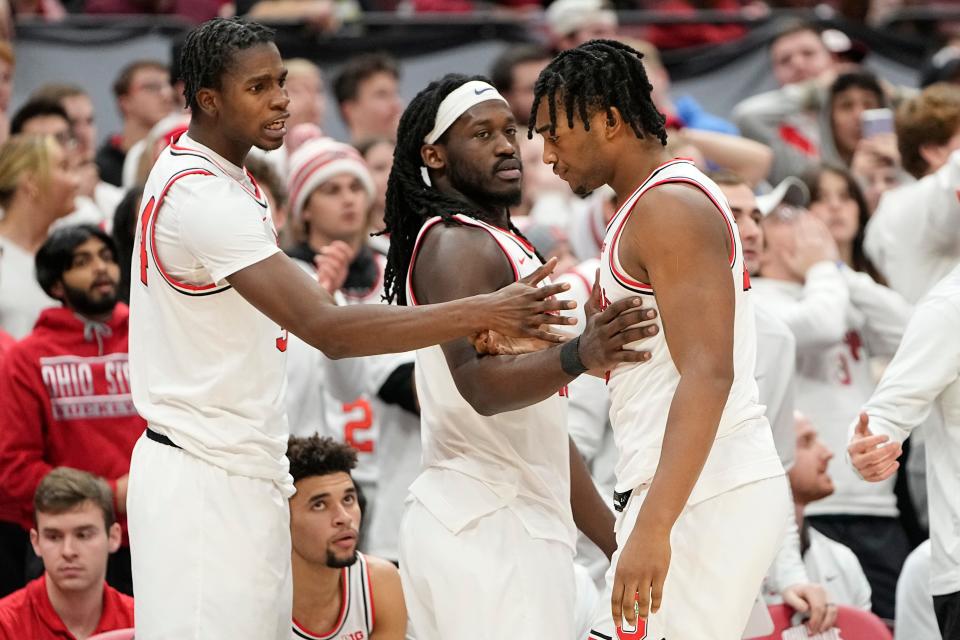How did Ohio State men's basketball get to this point? Here's a timeline
The new-look Buckeyes were scatted around the practice gym at Value City Arena as their coach looked to the start of the season. The 2022-23 preseason was about to get underway, and coach Chris Holtmann was embarking on a new era as his sixth season revved up.
Of the 14 players in uniform, only two had played in more than two Ohio State games the prior season. Including two walk-ons, 10 of the 14 had played their basketball elsewhere in 2021-22.
As he answered questions from reporters about what might lie ahead, Holtmann wasn’t worried about opening night, which would arrive when Robert Morris visited on Nov. 7. He was more focused on the immediacy of trying to get such a young team to figure things out as quickly as possible.
“Right now, the focus on trying to get them ready so I’m not thinking necessarily about opening night as much as getting them ready,” he said. “I’ve not coached a team that’s counted on four freshmen as much as this group is going to. There’s some real positives to that and what can we grow into? If we encounter some bumps along the way, what can we grow into? I think there’s a mixture of feelings.
“There’s certainly some anxiety, but some excitement, too.”
More than 50 games later, the former has outweighed the latter. After Ohio State let an 18-point lead disappear in a 76-73 home loss to Indiana on Tuesday, the second loss of the season in which it led by 18 points, the Buckeyes dropped to 13-11 overall and 3-9 in the Big Ten. Since the start of the 2022-23 season, Ohio State is 29-29 overall and 8-24 in conference play.
After going 20-12, earning a No. 7 seed and winning a game in the NCAA Tournament before losing two players to the NBA in 2021-22, how did Ohio State get here? Here are some of the key milestones along the way, some of which predate that season, as a Saturday home game with Maryland approaches.
Ohio State loses to Illinois and then Oral Roberts
Playing through the COVID-19 pandemic, Ohio State built an 18-4 record before dropping its final four games of the regular season to limp into the Big Ten Tournament. Playing inside Lucas Oil Stadium, with a smattering of socially distanced fans permitted, Ohio State took down Minnesota 79-75, Purdue 87-78 in overtime and Michigan 68-67 to advance to the title game despite losing lynchpin Kyle Young to a concussion along the way. The Buckeyes then led Illinois 81-80 with 2:33 left in overtime but came up just short of a tournament title, 91-88.
The effort took a toll. Emotionally drained and physically worn down, the Buckeyes went from the Big Ten’s “bubble” environment to the NCAA Tournament’s version while holding a No. 2 seed. Ohio State wasn’t quick enough on the perimeter or prolific enough offensively to slow down plucky Oral Roberts, and the 15-2 upset was only the ninth in March Madness history as the Golden Eagles won 75-72 in overtime. Two losses in six days denied the Buckeyes both a conference tournament title and the opportunity to make a Sweet 16 run.

The loss laid bare the truth that Ohio State was simply not good enough defensively. Although the Buckeyes finished fourth nationally in adjusted offensive efficiency, they bottomed out at No. 82 defensively – the lowest mark in Holtmann’s four seasons, a number that would soon be eclipsed. It also spent a lot of Holtmann’s goodwill with a fan base growing impatient waiting for its first Big Ten title since 2011-12 and Sweet 16 appearance since 2012-13.
The Buckeyes commit to rebuilding the roster by going young
It’s against this backdrop, and with potential seismic changes to roster building on the way, that Holtmann and Gene Smith developed a plan. As Ohio State started to make inroads with its 2022 recruiting class, the coach and athletic director decided to take a more traditional approach to constructing the roster. The Buckeyes committed to going young, building through traditional recruiting while adding complementary – but not necessarily game-changing – players via the transfer portal.
At the time, players were still largely required to sit out for a season before being eligible after a transfer. It’s decided that this is the best approach to build a sustainable winner, one that will endure some bumps in the early going as young players assume heavy roles but the payoff will hopefully be in 2023-24 and certainly in 2024-25.
To do this, Ohio State signed a five-man class in 2022 that featured four players among the top 90 nationally in the 247Sports.com rankings. The Buckeyes then stacked that class, ranked No. 8 nationally, with a four-man class in 2023 featuring three top-60 players that is ranked No. 12 nationally. In the process, the transfer portal was used to plug holes and provide supporting players, not bring in players who will stunt the development of the young guys.
Ohio State loses Meechie Johnson Jr. while trying to add via the transfer portal
A talented prep player from Northeast Ohio, Meechie Johnson Jr. graduated high school early, joined Ohio State amid the 2020-21 season and battled injuries during the 2021-22 season to finish averaging 4.4 points and 1.2 assists in 17.7 minutes per game. A player who cried in the locker room after a second-round loss to Villanova in the 2022 NCAA Tournament, Johnson cared about Ohio State at a high level but opted to enter the transfer portal when the Buckeyes tried to add another veteran piece in the backcourt.

Ohio State wound up losing Johnson and then missing out on Nijel Pack, a coveted Kansas State transfer who wound up signing with Miami as part of a controversial (at the time) NIL deal. The Buckeyes eventually signed Isaac Likekele, a guard who averaged 8.9 points, 5.5 rebounds and 3.9 assists as a four-year starter at Oklahoma State, left the team midseason to deal with some family issues and never replicated the form he had showed with the Cowboys. He averaged 3.8 points, 4.0 rebounds and 2.8 assists while shooting 38.8% from the floor, all career-low totals, in his lone season with the Buckeyes.
Johnson is averaging 14.5 points, 4.2 rebounds and 3.0 assists in his second year at South Carolina as the Gamecocks are making a surprise run to the top of the SEC standings.
Coaching staff endures some shake-ups
Holtmann lost his top assistant when associate head coach Ryan Pedon took the head coaching job at Illinois State in 2022. It was an expected move for Pedon, who had long been viewed as a future head coach.
It wasn't the only departure that offseason, though. After just one year at Ohio State, Tony Skinn took an assistant coaching job at Maryland, where he was reunited with newly hired head coach Kevin Willard. A native of the Washington D.C., region, the move was a homecoming for Skinn, and it wasn't a long one. A rising star in the profession, Skinn was hired as George Mason's head coach in 2023, and the Patriots are 15-8 in his first season.
Holtmann hired Jack Owens, former Miami (Ohio) coach and a Purdue assistant, to fill one of the jobs and promoted Mike Netti to full-time assistant to fill the other.
Zed Key suffers a shoulder injury
With a breakout junior season underway, Zed Key was averaging 13.4 points and 8.4 rebounds, had posted five double-doubles and was shooting 69.8% on two-point field goals when he banged into Purdue’s Zach Edey in the 14th game of the 2022-23 season. The resulting shoulder injury would eventually require season-ending shoulder surgery, but first he would gut it out while playing with a heavy brace on his left shoulder and averaging 8.8 points and 7.2 boards while shooting 46.3% on two-point field goals.

In his absence, Felix Okpara ascended to the starting spot and then opened 2023-24 as the starter with Key coming off the bench. But as the Buckeyes lost 13 of 14 games that season, it’s fair to wonder if a healthy Key’s ability to consistently score in the post could have helped steadied the ship when offense dried up and provided some confidence to a youth-laden team in clear need of finding some.
His playing time has dropped in his fourth year, and the limited action has coincided with a dip on Key’s effectiveness. He’s shot 51.1% from two since the injury.
Brice Sensabaugh leaves for the NBA
Brice Sensabaugh wasn’t on any mock draft, or seemingly under any consideration to be added to one, when he arrived on Ohio State’s campus during the summer of 2022. Injuries and the COVID-19 pandemic had combined to help the Orlando native stay largely under the radar, and when Dillon Mitchell privately committed to Ohio State only to change course and eventually sign with Texas the Buckeyes were able to make quick inroads and sign Sensabaugh.
His offense immediately translated to the college level even as his defense lagged well behind, and on an Ohio State team struggling to score Sensabaugh was able to assume center stage and showcase the No. 1 skill NBA teams prize: the ability to create and make his own shot. He averaged 16.3 points while shooting 40.5% from 3 for the Buckeyes, and that was enough to play his way into the first round of the NBA draft. Utah took him at No. 28, and he’s spent nearly the entirety of his rookie season putting up gaudy numbers for the Jazz’s G-League affiliate.

To replace his absence, and the loss of forward Justice Sueing, Ohio State signed Minnesota fifth-year transfer Jamison Battle in the portal. He’s shooting a career-best 44.1% from 3 and has been a significant addition to the roster, but no player on this Ohio State roster can go get a bucket like Sensabaugh could.
Tanner Holden transfers out
It wasn’t just the freshmen who were expected to take lumps and grow into bigger roles in 2023-24. Ohio State added transfer wing Tanner Holden, a prolific scorer at Wright State, who came to the Buckeyes with two years of eligibility and an expectation that he would acclimate to the high-major level. During the summer of 2022, the belief was that Ohio State’s starting lineup in 2023-24 would be Bruce Thornton, Roddy Gayle Jr., Holden, Sensabaugh and either Okpara or Key.
Instead, Holden averaged 3.6 points and 2.4 rebounds at Ohio State, was a healthy, unused substitute in eight games including seven straight and transferred back to Wright State. Entering Thursday night’s game with Detroit Mercy, he was averaging 16.3 points and 6.3 rebounds.
Ohio State Buckeyes: Join the Ohio State Sports Insider text group with Bill Rabinowitz, Joey Kaufman Adam Jardy
Transfer portal again lands mixed results
After going 16-19, Ohio State retained youthful pieces Thornton, Gayle and Okpara as well as a fully healthy Key. The Buckeyes also welcomed in a four-man recruiting class, ultimately leaving three roster spots to fill via the portal.
In addition to Battle, Evan Mahaffey arrived after one season at Penn State with a high-upside profile and Dale Bonner as a veteran backup guard who had spent the last two seasons at Baylor.
Mahaffey has shown signs of growing into a standout player, but he is one of four sophomores in the starting lineup for the Buckeyes and has not been able to provide the type of leadership that comes from experience. That’s a role that was supposed to be handled at least partially by Bonner, who was ticketed to play 15-20 minutes in order to free up Thornton and Gayle. Bonner earned a preseason reputation as the faster player on the roster, and the belief was that his pace would give Ohio State’s attack another dimension.
That has not materialized. At the Division I level, he’s averaged a career-low 1.3 assists and 0.6 steals while shooting 29.3% from 3-point range. In Big Ten play, Bonner is playing 14.3 minutes and averaging 2.5 points, 1.4 assists and 0.4 steals while shooting 18.2% from 3 and 23.3% overall.
Get more Ohio State basketball news by listening to our podcasts
This article originally appeared on The Columbus Dispatch: What events have led Ohio State men's basketball to this point?
